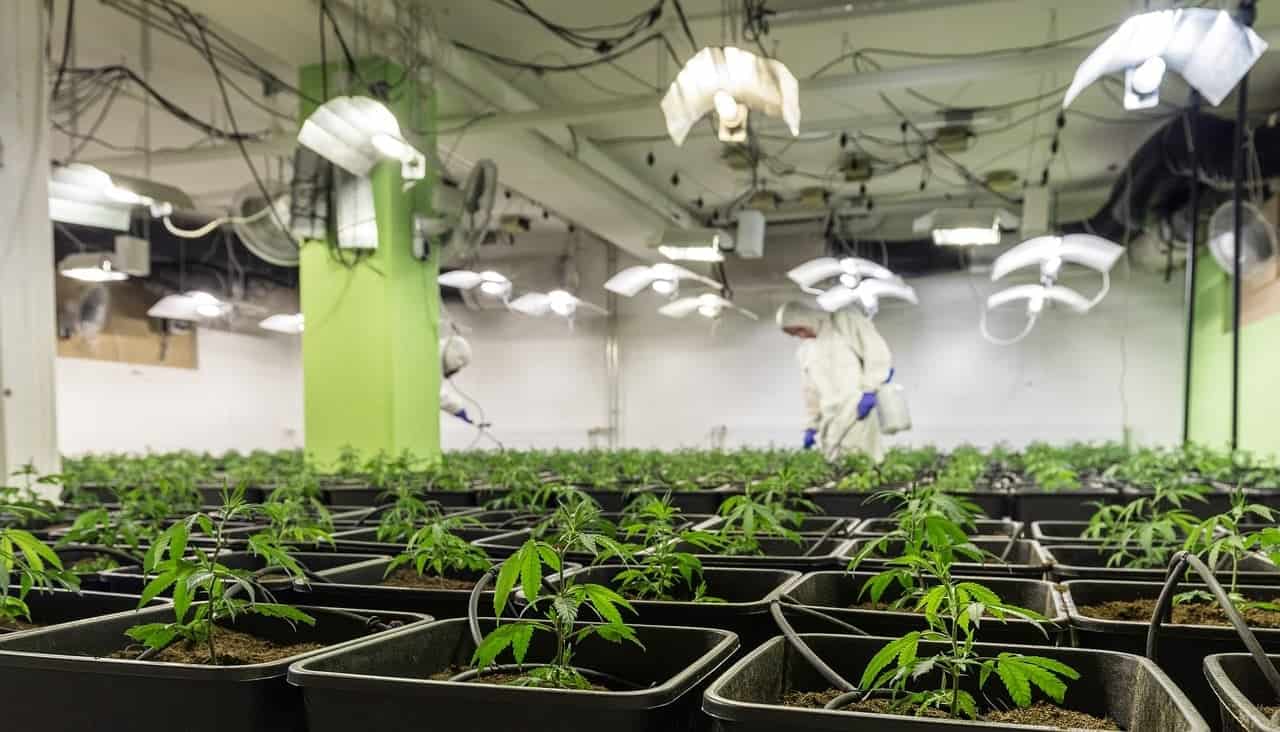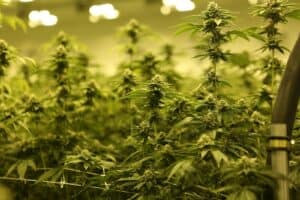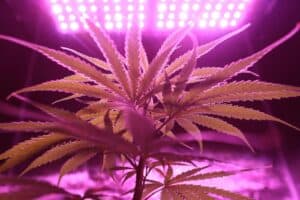Key Points
- Cannabis canopy is defined as the uppermost portion of cannabis plants that has leaves and buds exposed to light.
- It is important to manage the canopy as it enhances plant health and productivity.
- Cannabis can be beautified, and its yield can be improved by training, trimming, and trellising.
- Managing the canopy requires more than just techniques, as environmental factors such as light, humidity, and airflow also contribute significantly.
- Implementing proper management of the canopy will help achieve enhanced photosynthesis, thus assisting in general plant productivity.
While the phrase “cannabis canopy” may appear scientific, it is a basic concept that all cannabis professionals learn early on. In essence, the cannabis canopy refers to the topmost layer of the plant, which is where the photosynthetic leaves and buds are situated. This region is focused on significantly lighted regions in a plant’s cells. Working with the canopy properly can affect both the quality and overall weight of the harvest. In this article, the focus will be on the measurement, science, and art of cannabis canopy management that exposes growers of every level to different actionable techniques.
What is Cannabis Canopy?
Few know that the cannabis canopy is vital for the plant’s growth and development. Proper canopy growth is essential, as the leaves in this area capture sunlight and facilitate photosynthesis, the process that fuels the plant’s energy needs. It is important to mention that improper canopy management can cause poor light penetration, lack of airflow to the plants, and poor yield. Effective canopy management is crucial to maintaining a competitive advantage and ensuring robust plant health.
On the other hand, a canopy that is well-managed enhances the following:
- Maximum utilization of light: It is possible to enable an even light penetration into the canopy because the leafy parts and buds enable an ordered penetration to take place.
- Better Airflow: A well-engineered canopy structure manages the humidity in the canopy, greatly reducing the chances of mold and pests.
- Improved Yields: Without a doubt, well-maintained plants will grow healthier and produce more robust buds thanks to proper canopy management.
- Energy Efficient: Any wastage is reduced when growing because exposures to light are maximized, thus making growing more environmentally friendly.
What Environmental Factors Influence Canopy Growth?
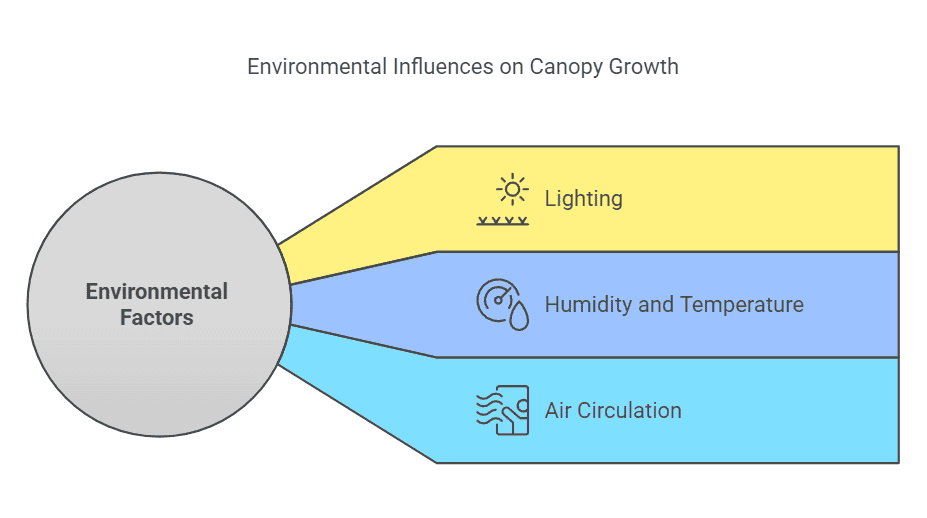
Effectively managing the plant canopy is more than just training or pruning the plants. The environmental aspects are also critical in deciding to what extent the canopy may flourish.
- Lighting
The cannabis plant needs particular light spectrums for optimal growth. Blue light during the vegetative stage facilitates leafy growth, while red light growth is critical in the flowering stage. The correct placement of grow lights ensures that all regions of the canopy are sufficiently lit.
- Humidity and Temperature
The humidity and temperature levels of the growth room should always be regulated. High humidity can encourage the growth of mold and mildew, while less moisture can place the plants under stress. Extreme temperatures can also inhibit growth and lower yields.
- Air Circulation
To further avoid creating microclimates within the canopy, adequate airflow must be utilized. This will aid in pest and disease prevention—simple tools such as oscillating fans and adequate ventilation aid in sustaining the airflow.
How to Manage Your Cannabis Canopy
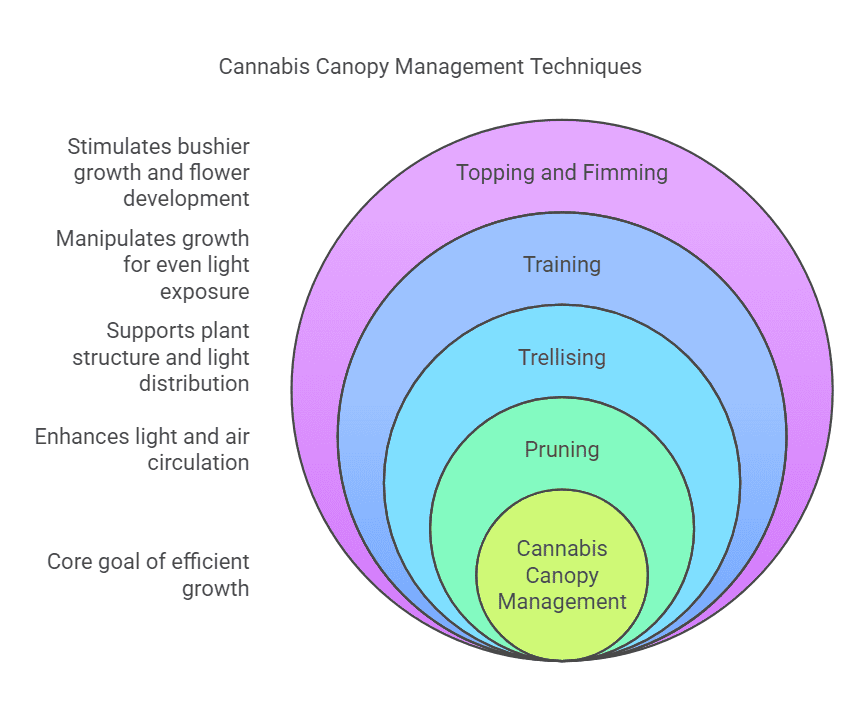
To create an efficient cannabis canopy, a gardener must implement various techniques. These approaches can be designed to match the equipment used, regardless of whether the setup is outdoor or indoor.
- Pruning
Pruning refers to the removal of some portions of leaves and stems for improved circulation, penetration, and airflow, especially targeting the lower branches. Two main categories are well-known:
- Defoliation is the removal of wet leaves located on the upper portions of the plant to allow light to reach the lower sections.
- Lollipopping: Cutting the lower sections of the plant to ensure the top sections receive the most energy.
Both methods work to ensure that the plant spends its energy producing high-quality buds and doesn’t waste energy growing excess leaves.
- Trellising
Trellising uses devices such as nets or stakes to help maintain plants in specific-shaped molds. This method lowers the risk of a branch snapping under the weight of heavy buds while evenly distributing the canopy for maximum light exposure.
- Training
Training a plant consists of low-stress training (LST) and Screening of green (ScrOG), which both change the plants’ natural growth pattern by manipulating growth hormone distribution. These methods promote growth that is more sideways, making the top of the plant evener.
- LST: Slightly bending and tying down branches so they expose more nodes to receive light
- ScrOG: Employing a screen to enable the spreading of the canopy to ensure more uniform light distribution among the plants[1].
Ensure each part of the plant gets its fair share of light and nutrients for uniform growth and higher yields.
- Topping and Fimming
Topping and fimming change the regular growing of cannabis plants to enhance the development of flowers.
- Topping: Cutting the tip of the main stem to stimulate the development of two stems gives the plant a bushier appearance[2].
- Fimming: Instead of fully cutting the main stem, the cut is only done partially, allowing the cut to grow multiple new branches instead.
This increases the number of buds and helps to give the plants an even canopy.
How to Monitor and Adjust Canopy Health
Nutrients and adjusting canopy health are vital for maximizing yield and quality in cannabis cultivation. This process involves tracking key metrics such as temperature, humidity, and light intensity and observing for signs of stress or disease.
Growers can use various tools, including sensors and cameras, to monitor the canopy and identify areas for improvement. Regular pruning and training are also essential for maintaining a healthy canopy and promoting even growth. By using data analytics, growers can track canopy health and productivity over time, identifying trends and patterns that can inform future decisions.
By continuously monitoring and adjusting canopy health, growers can ensure a robust and productive crop, even in the face of new challenges and market fluctuations.
What Are the Challenges in Canopy Management?
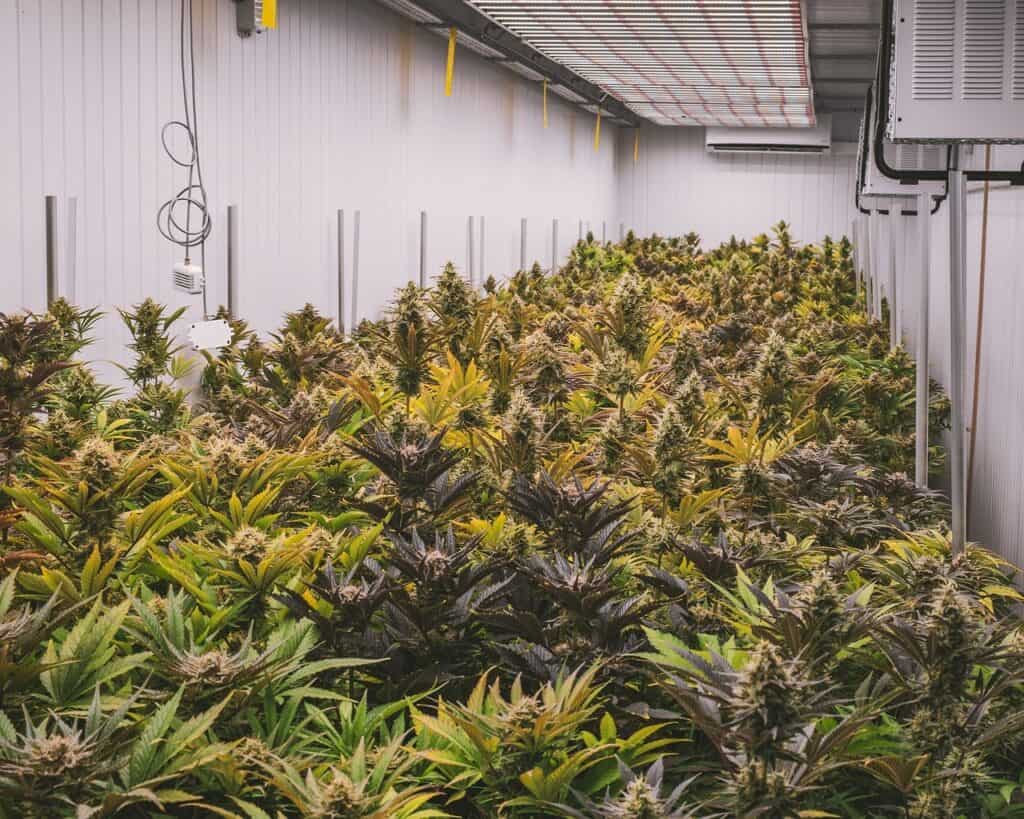
Canopy management of cannabis is not an easy task and is riddled with problems. Here are some of the issues you are likely to face as a grower alongside their solutions:
- Differential Growth: The unevenness of canopy growth can be remedied by regular pruning and plant training.
- Light Burn: Adequate distance between the grower lights and the plants will avoid the burning of leaves.
- Pests and Mold: A regular check-up and ensuring proper environmental parameters can help in overcoming these challenges.
- Overcrowding: Adequate inter-plant spacing and the introduction of trellises can solve the problem of plant overcrowding and assist air movement to a degree.
Pest and Disease Management in Relation to Canopy
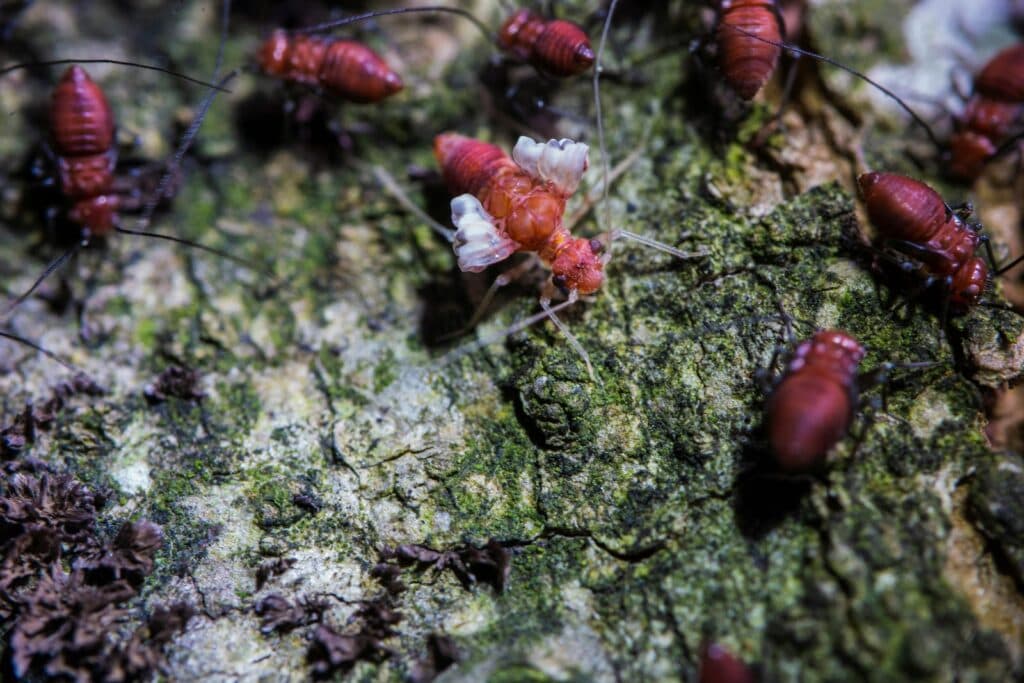
Adequate airflow is a critical aspect of maintaining a healthy cannabis canopy. Common issues that growers face include spider mites, aphids, and powdery mildew, all of which can quickly spread and devastate a crop if not addressed promptly.
Growers can implement integrated pest management (IPM) techniques to prevent these problems. This approach involves a combination of methods, such as introducing beneficial insects that prey on pests, applying organic pesticides, and maintaining good sanitation practices. Regular monitoring and inspection of the canopy are essential for early detection and intervention, reducing the risk of severe infestations.
Physical barriers, such as fine mesh screens, can also be effective in preventing pests from entering the grow space. Additionally, biological controls like neem oil and diatomaceous earth can help manage pest populations without harming the plants. By employing these strategies, growers can protect their cannabis canopy from common pests and diseases, ensuring a healthy and productive crop.
Are There Any Case Studies of Canopy Management?
Let us look at some case studies that demonstrate the use of canopy management in their performance.
Indoor Cultivation
One of the indoor growers practicing the ScrOG approach increased yields by 20% with a well-managed canopy. This allowed for the even distribution of a plant’s growth horizontally, allowing light to penetrate and reducing shading.
Outdoor Cultivation
An outdoor grower combined topping and LST for their plants, ensuring that even the lower branches received adequate light exposure. The result was a more bushy structure that further increased sunlight penetration and more dense buds.
Conclusion
Well-managed canopy is a key aspect of cannabis cultivation and thrives when the environment is appropriately controlled. A combination of prune, trellis, and training greatly improves the plant environment. The management of the canopy enables you to unlock the full potential of cannabis plants.
FAQ
- What is the cannabis canopy?
The cannabis canopy refers to the upper layer of the plant where leaves and buds are exposed to light. This is of utmost importance for plant physiology, that is, for photosynthesis and other plant processes.
- Why is there a need for canopy management?
Canopy management guarantees even distribution of light penetration and air movement, which means higher productivity. Moreover, it reduces the chances of mold and pest invasion.
- What methods are effective in cannabis canopy?
Pruning, trellising, Low-Stress Training (LST), Screen of Green (ScrOG), topping, and fimming are suitable for cannabis canopy management.
- Do environmental factors impact the canopy?
Light, humidity, temperature, air circulation, and nutrients are among many other factors influencing the health and productivity of the cannabis canopy.
- Can we use canopy management to improve both indoor and outdoor cultivation?
Yes, it is possible to use canopy management in both cases to improve indoor and outdoor cultivation. Approaches do vary according to the cultivation environment.
References
- Knight, Glenys & Hansen, Sean & Connor, Mark & Poulsen, Helen & McGovern, Catherine & Stacey, Janet. (2010). The results of an experimental indoor hydroponic Cannabis growing study, using the ‘Screen of Green’ (ScrOG) method-Yield, tetrahydrocannabinol (THC) and DNA analysis. Forensic science international. 202. 36-44. 10.1016/j.forsciint.2010.04.022.
- Gaudreau, Sylvain & Missihoun, Tagnon & Germain, Hugo. (2020). Early topping: an alternative to standard topping increases yield in cannabis production. Plant Science Today. 7. 627-630. 10.14719/pst.2020.7.4.927.

